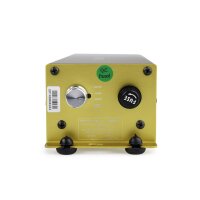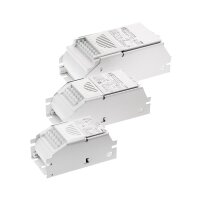Electronic ballasts
Conventional ballasts for lighting systems are available with a wattage specification of 70W, 150W, 250W, 400W and 600W, up to 1000W.Adjustable ECGs with dimmer from 250W to 1000W
Normal magnetic ballasts each have a fixed wattage, whereas electronic ballasts can usually be regulated, sometimes even across the entire spectrum of possible wattage ratings for high-pressure lamps - so in the best case scenario, you can master all grow situations with a single dimmable ballast. This can even be achieved with just a single lamp, provided that the ballast and lamp are of good quality:
With the various dimmer settings of a 600W ECG and a 600W grow lamp, for example, a complete life cycle can be illuminated, from cultivation (lowest output) to shortly before harvesting (highest output). Of course, it is more elegant to change the light source.Brief overview of the advantages of electronic ballasts for indoor growing
KVGs with fixed wattage - from 70W to 1000W
KVGs, i.e. conventional ballasts, are used in indoor growing to operate the powerful high-pressure and gas discharge lamps. They almost always have a specific wattage specification, so the output power cannot be regulated. Common power categories are 70W, 150W, 250W, 400W, 600W and 1000W. They are therefore more suitable for growing situations in which different illuminance levels are not required for different phases of the plants.Connecting the ballast to the right grow lamp
The output of the conventional, magnetically operating ballast must match that of the lamp. Connecting a ballast that is too strong to a lamp means operating the light source at too high an output, which will sooner or later lead to a defect.
The effect of a ballast that is slightly too weak is not so drastic, as the lamp will work without any problems, but will be operated below its maximum wattage - unless you use a wattage that is much too low, so that the ballast cannot cope effectively with the current flow and the lamp is damaged by the negative voltage that is constantly present.Wrong combination - what happens?
Old technology vs. innovation
Conventional ballasts have more or less reached the zenith of their development and are increasingly being replaced by electronic versions, so-called ECGs. There are good reasons for this, as electronically controlled devices are lighter, more efficient, adjustable and often have comprehensive control programmes.
However, an invaluable advantage of this time-honoured technology is its reliable operation and low susceptibility to faults. A conventional ballast also does its job on an unreliable power supply and is insensitive to voltage peaks. It works with virtually any grow lamp with the correct wattage setting.
A correctly connected ballast will run for years without any problems, no matter how many operating hours it accumulates. As it works purely electrically and does not contain any additional circuits, it does not cause any disturbing interference that could affect nearby radios, televisions or computers, for example.




